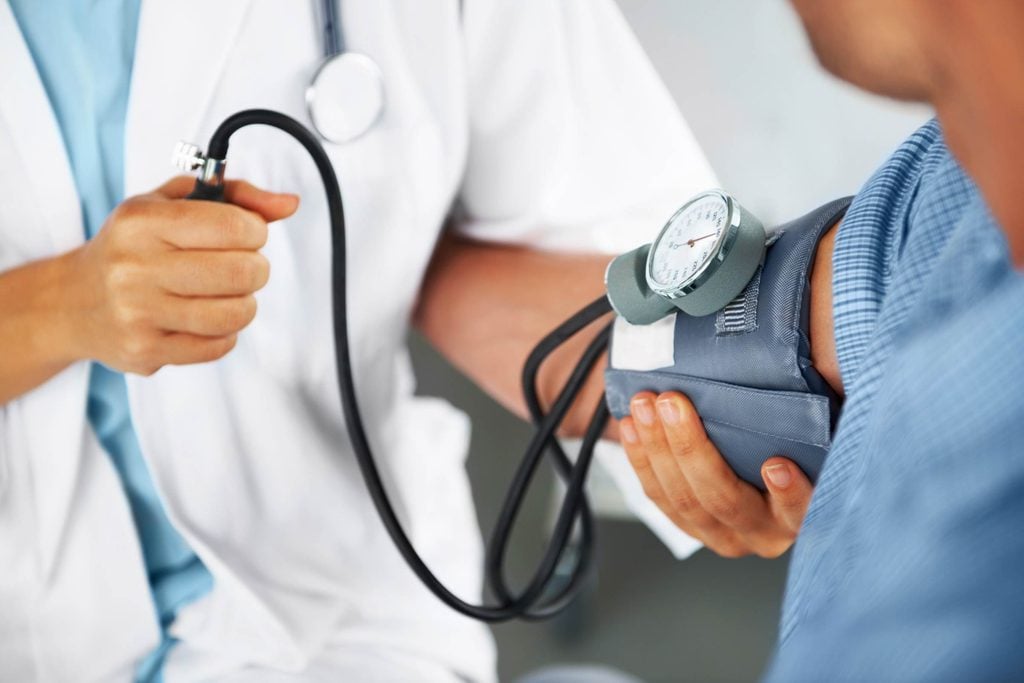Stick to This Diet to Lower Blood Pressure—and Finally Get Off Medication
Updated: Sep. 29, 2020
Tired of being sick and tired? This diet might be the answer you've been looking for.
 Sure, you know you should cut down on the salt if you have high blood pressure and “bad” LDL cholesterol, but it’s tough to know what a healthy, low-sodium diet should look like. The Dietary Approaches to Stop Hypertension (DASH) diet was designed to help lower blood pressure and LDL, not weight loss.
Sure, you know you should cut down on the salt if you have high blood pressure and “bad” LDL cholesterol, but it’s tough to know what a healthy, low-sodium diet should look like. The Dietary Approaches to Stop Hypertension (DASH) diet was designed to help lower blood pressure and LDL, not weight loss.
The DASH diet is simple and doesn’t require calorie-counting or overly restricting food choices. The general guidelines include:
- 6 to 8 servings of whole grains a day
- 4 to 5 servings of vegetables a day
- 4 to 5 servings of fruit a day
- 2 to 3 servings of low-fat or fat-free dairy products a day
- 6 or fewer ounces of lean meat, poultry, and fish a day
- 4 to 5 servings of nuts, seeds, and beans a week
- 2 to 3 servings of healthy fats and oils a day
- 5 or fewer sweets a week
- 2,300 mg or less of sodium a day
On average, a person following the DASH diet will drop systolic blood pressure (the upper number in a reading) by about 10mmHg, says Nieca Goldberg, MD, cardiologist and medical director of the Joan H. Tisch Center for Women’s Health at NYU Langone Medical Center. “That’s really quite dramatic,” she says. In comparison, dieting for weight loss gives just a 3mmHg reduction, says Dr. Goldberg.
If you follow the DASH diet, cut sodium down to 1,500 mg a day, and exercise, you could even lower blood pressure up to a whopping 25mmHg, says Martha Gulati, MD, cardiologist at The University of Arizona and editor-in-chief of cardiosmart.org. “There are very few medications, even in the highest doses, that reduce blood pressure that much,” she says. By changing your lifestyle, you might be able to cut down on the number of medications you need—or even stop taking them entirely, says Dr. Gulati.
Even if you know you should cut down on salt, you might not realize how bad the problem is. The average American eats 3,400 mg of salt a day, says Dr. Goldberg. “That’s entirely too much,” she says. By focusing on fresh foods instead of processed ones, the DASH diet minimizes salt without sacrificing flavor.
One of the main factors driving the DASH diet’s success is its emphasis on produce. Fruits and veggies are packed with important nutrients, and the potassium, magnesium, and calcium can actually counteract sodium’s blood pressure-raising effects, says Dr. Gulati. “Eat a rainbow diet,” she says. “The more colors are in it, the more vitamins and minerals you’re probably getting, and you’re also getting more fiber.” Stick with fresh produce when you can. Canned—and sometimes even frozen—vegetables can be sneaky sources of sodium, so read the label first. If you are opening a can of veggies or beans, she recommends rinsing the contents under cold water to wash away some of the extra sodium.
Whole grains also contain beneficial potassium, magnesium and calcium, and could help keep you satisfied on the produce-heavy DASH diet. But remember: Not all grains are created equal. Simple carbohydrates, like white rice, pasta, and processed cereals, don’t have much nutritional value because their natural fiber and nutrients are removed during processing. “You’re looking for more complex carbohydrates,” says Dr. Gulati. “They take longer for the body to digest, and lower cholesterol, and are more filling than a simple carbohydrate.” Look for labels that say 100 percent whole grain or 100 percent whole wheat, she says.
The DASH diet calls for low-fat and fat-free dairy, which are chock-full of calcium to lower blood pressure. Just be mindful that some products replace the fat with other unhealthy additives. “You have to read the food labels because things like cottage cheese and some low-fat cheese are higher in salt,” says Dr. Goldberg.
Six or fewer ounces of lean meat, poultry, and fish a day might not sound like a lot, but that should be plenty of protein to power you through the day. “Contrary to what people think, you don’t need a large amount of protein if you’re not an extreme athlete,” says Dr. Gulati. “Six ounces isn’t going to take up half your plate—it will be a small portion of your plate.” By cutting down on meat, you’ll reduce your intake of “bad” saturated fat, which could raise your cholesterol if you eat too much, says Dr. Goldberg. Swap for fish, though, and you’ll get a rich source of heart-healthy omega-3 fatty acids instead. Cut the skin off poultry, and grill or bake fish instead of frying to keep your protein sources healthy, says Dr. Goldberg.
The DASH diet is easy to follow when you’re cooking for yourself, says Dr. Gulati, but eating out can throw you off. Restaurant food is notoriously salty and fatty, but some simple modifications can make your meal healthier. Premade soups and sauces are hard to adjust, but request that the chef doesn’t add any additional salt or cook your dish in butter, she says. Add spices and herbs if you crave more flavor. Subbing balsamic vinegar and olive oil for premade dressings, and saying no to the bread basket are other easy ways to cut down sodium. “You have more control in restaurants than you realize,” says Dr. Gulati. “You’re paying for it—you should ask for it to be done the way you want it.”
MORE: 8 Things That Happen to Your Body When You Don’t Eat Enough Fruits and Veggies
















